Hydrangea large-leaved Alpengluchen - detailed description
The perennial hydrangea Alpengluchen, originally from Japan, southern China, is one of the most beautiful varieties with bright inflorescences and long flowering. Consider the main characteristic of the variety, the rules of cultivation and care.
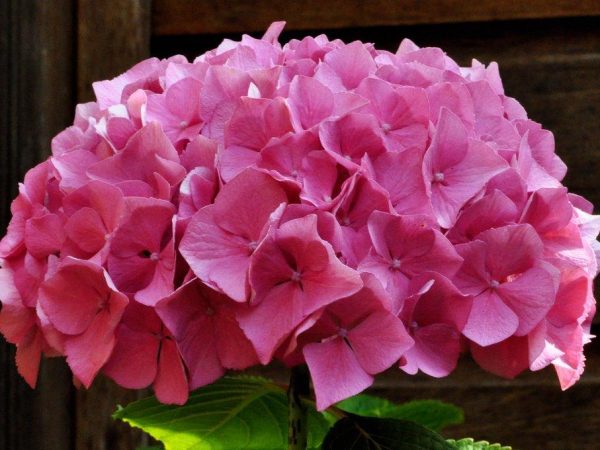
general description
The botanical name is hydrangea macrophylla alpengluhen. The variety has a weak frost resistance, therefore it needs insulation for the winter. The main feature is the ability to maintain a rich red hue of flowers, even when grown in acidic soil.
It differs from other varieties:
- perennial shrub with a spherical, dense crown 1.2 m high with the same diameter;
- leaves are bright green, oval or rounded, pointed at the tip with a smooth surface;
- inflorescences are large, spherical, circumference 20-25 cm, dark pink or red tone;
- flowering begins in late July or early August on annual shoots and ends in late autumn.
Landing rules
Timing
Young hydrangea bushes are planted in spring, when the soil warms up to 10-12 ° C and the last frosts pass.
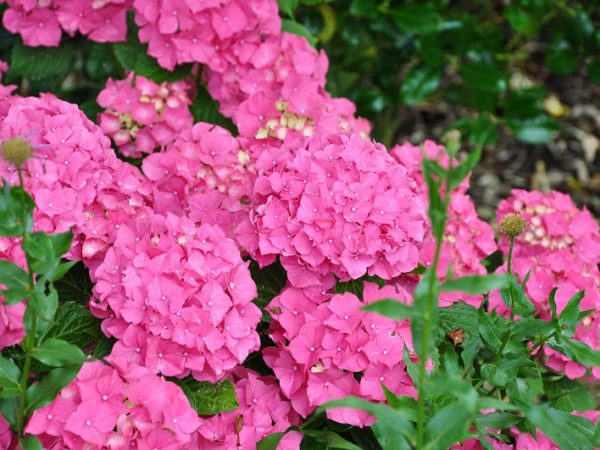
Hydrangea alpengluchen
This usually lasts from mid to late April. Autumn planting is allowed in the southern zone - until the first half of September. This will allow the seedlings to take root and prepare for the coming winter.
Seat selection
When grown in regions with hot summers, it is better to choose a shaded place where the sun shines in the morning and evening. In the northern and middle lane, a site well-lit by the sun is chosen.
Hydrangea does not like drafts, so you need to plant it where there is protection from the winds. It also develops poorly on swampy land. Better to plant on a hill or provide good drainage.
The acidity level of the soil does not matter, therefore, it is not worth deoxidizing or adding components to increase it.
The soil is suitable for light, loose, loamy or sandy loam. In the first case, add 20 kg of sand, perlite or vermiculite. When planting on sandy loam, the place is sprinkled with clay (two buckets). The plot is dug up, leveled, watered.
Seedling preparation
You can buy a young bush in any gardening nursery.
Choose seedlings with multiple stems, at least 50 cm in height, planted in containers or with an earthen ball.
When buying, carefully inspect the crown - the twigs and leaves should be whole, without mechanical injuries, signs of disease and parasites.
Before planting, the roots are dipped in cold water for two hours, then cut to 2-3 cm in length. This will help them take root and grow faster.
Landing technique
The pits are harvested two weeks before the planned landing. Their approximate depth is 30 cm, width is 40 cm. In group cultivation, a distance is maintained - at least 1.2 m, the same amount in a row.
A third is filled with a drainage mixture of pebbles, crushed stone, screenings. Then they fill it with a fertile composition - mix humus, leafy soil, peat and sand in a ratio of 2: 2: 1: 1.
The roots are lowered in the center of the hole so that the root collar remains above the soil surface. They fill up all the voids, tamp them, water them. 20 liters of water are poured under one bush. The next day, they loosen and add peat mulch.
Care features
It is not difficult to take care of this perennial shrub, the main thing is to carry out all the activities on time and correctly.
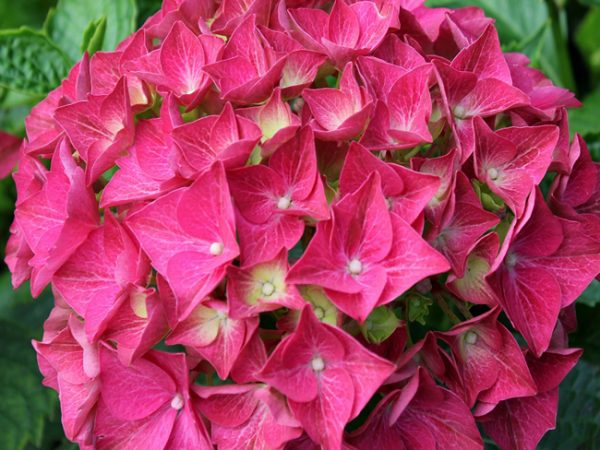
Hydrangea large-leaved alpengluchen
Watering
This is a moisture-loving culture, so it needs to be watered often, but in moderation, in order to prevent waterlogging and root rot.
In the first two weeks, the seedling is moistened every other day - two buckets of water are poured out. So it will take root faster.
Further watering is carried out as the earth dries out to a depth of 4-5 cm. Moistening is required in early spring, before and after flowering, as well as in autumn, when the shrub enters the dormant phase.
Loosening and mulching
The first procedure helps to maintain the moisture and breathability of the soil. It is carried out the next day after watering. Depth - 5-6 cm. They also weed the soil between the bushes, remove weeds.
Mulch is introduced from peat, leaf compost to prevent rapid evaporation of moisture.
Top dressing
They begin to feed in the third year of development. In the spring before the beginning of the growing season, sprinkle with urea (25 g), superphosphate (40 g) and potassium sulfate (30 g) per 1 m².
The second feeding is carried out at the stage of budding - 80 g of superphosphate and 45 g of potassium sulfate are spent on the same area.
In the fall, when the shrub has faded and shed its foliage, humus or compost is covered up in the near-trunk zone - 10 kg / m². All top dressing is combined with watering to improve the quality of nutrient absorption.
Pruning
The main care consists in carrying out regular haircuts, which helps to increase decorativeness and prevent the appearance of infections, parasites.
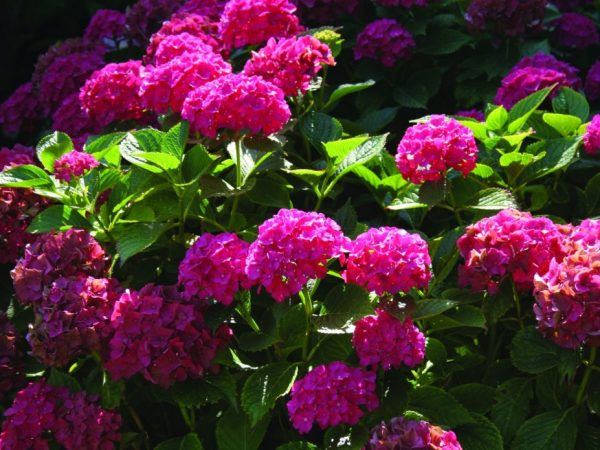
Hydrangea alpengluchen large-leaved planting and care
Throughout the growing season, branches are cut that are damaged by wind, disease, frost. Shoots that grow inward and thicken the crown are also cut out.
Dried buds are left on the bushes until spring - they create additional protection for the buds and stems from freezing in winter. They are removed after removing the shelter in the spring season.
Preparation for wintering
Regardless of age, this culture needs good insulation. On the eve of autumn cold weather, the trunk circle is mulched with a thick layer of peat, sawdust or fallen leaves (15 cm). The twigs are neatly tied into a bunch, covered with spruce branches, then wrapped in burlap or roofing felt.
Under such insulation, the bush will not rot or freeze. The shelter is removed in the spring, when the snow thaws and the threat of return frosts has passed.
Reproduction
Gardeners use two effective and proven methods of propagation of this crop - cuttings and stem layers.
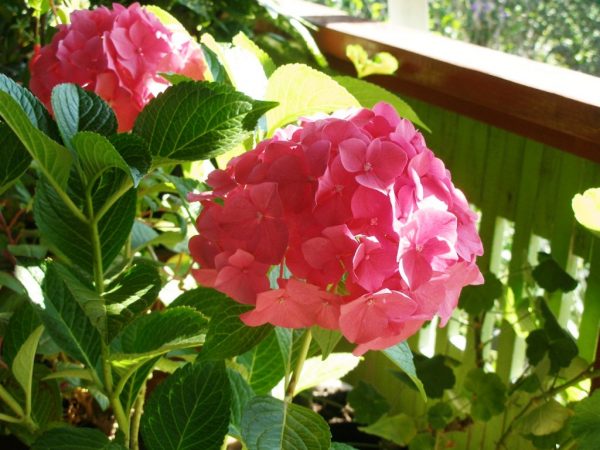
Hydrangea alpengluchen description
Cuttings
The planting material is cut in the spring or summer. Take the apical branches of the current year with two internodes, leaves and buds.
At the bottom, an oblique cut is made, the leaves are removed, then dipped into one of the root formation stimulants. After an hour of exposure, they are planted in a wet peat-sand mixture to a depth of 3-4 cm. Water, cover with foil, put in a well-lit place.
Until the moment of rooting (2-3 weeks), the seedlings are ventilated every day, moistened as needed.
The shelter is removed after the appearance of new leaves. After a month of home growing, they are transplanted to the site in the same way as purchased bushes.
Layers
The breeding procedure begins in late autumn. On an adult bush, choose a flexible lignified branch close to the ground.All the leaves are removed on it, lowered in a horizontal position into a groove to a depth of 5-6 cm. Sprinkle with a mixture of humus, peat and sand, watered.
On the eve of the first frost, they are covered with sawdust or fallen leaves, covered with spruce branches.
In the spring, when the snow melts, the shoot is dug up, cut off from the mother bush, divided into parts so that each one has roots. They are seated separately in the garden.
Diseases and pests
With good care and compliance with all the rules of growing, hydrangea Alpengluchen has strong immunity. Weakened bushes growing in thickets are susceptible to infection without proper care and attention.
It suffers from rust, downy mildew, gray and white rot. In the fight against these diseases, fungicides are used - Skor, Hom, Ridomil Gold, Bordeaux liquid or copper sulfate.
From pests (aphids, spider mites) insecticides will help - Actellik, Aktara, Karbofos or Fitoverm. If a shrub is affected by a nematode, it should be dug up and destroyed, since it is impossible to get rid of this parasite. The place of growth is spilled with copper sulfate.
Growing difficulties
Often gardeners, especially inexperienced ones, make various mistakes in care and cultivation, as a result, the bush grows slowly, blooms poorly or dies at the initial stage of growth:
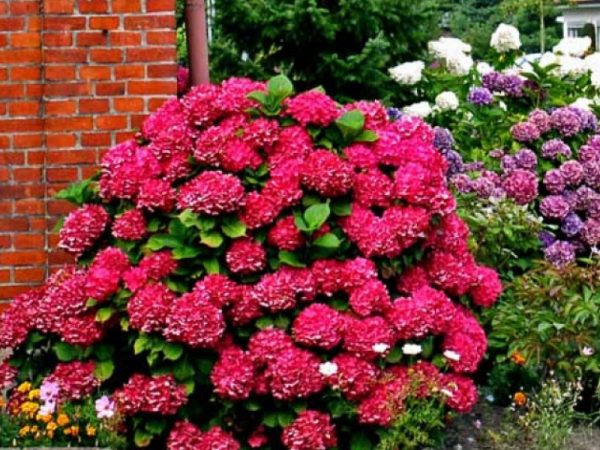
Hydrangea alpengluhen
- purchase of infected seedlings, therefore, when choosing, you should carefully examine the crown and root system;
- non-compliance with the planting scheme - in the thickened hydrangeas become infected with infections and pests;
- from frequent overflows, the roots begin to rot, and from a lack of moisture they dry out, it is important to adhere to the irrigation regime, taking into account seasonal precipitation;
- untimely pruning of diseased and mechanically damaged areas can provoke the appearance of diseases and a loss of decorativeness;
- An excess of fertilizers in the soil reduces the quality of flowering, contributes to yellowing of the foliage, so observe the dosage and frequency of feeding.
Application in landscape design
This plant is of great value in the landscape - it is planted singly, used in group plantings, combined with other varieties of hydrangeas.
Looks beautiful in mixborders, on flower beds with roses, rhododendrons, azaleas.
Decorates any corner of the garden, the local area, the area near the gazebos. They are planted in groups along the fence to get a lush and brightly blooming composition.
Variety reviews
Thanks to numerous positive reviews, the Alpengluchen large-leaved hydrangea has gained great popularity among gardeners:
- colorfully and blooms for a long time, therefore, it is an irreplaceable decoration of the garden in the autumn season;
- successfully multiplies, which makes it possible to independently grow varietal seedlings for landscaping the backyard area;
- universal culture goes well with different vegetation, suitable for decorating a garden in any style.

